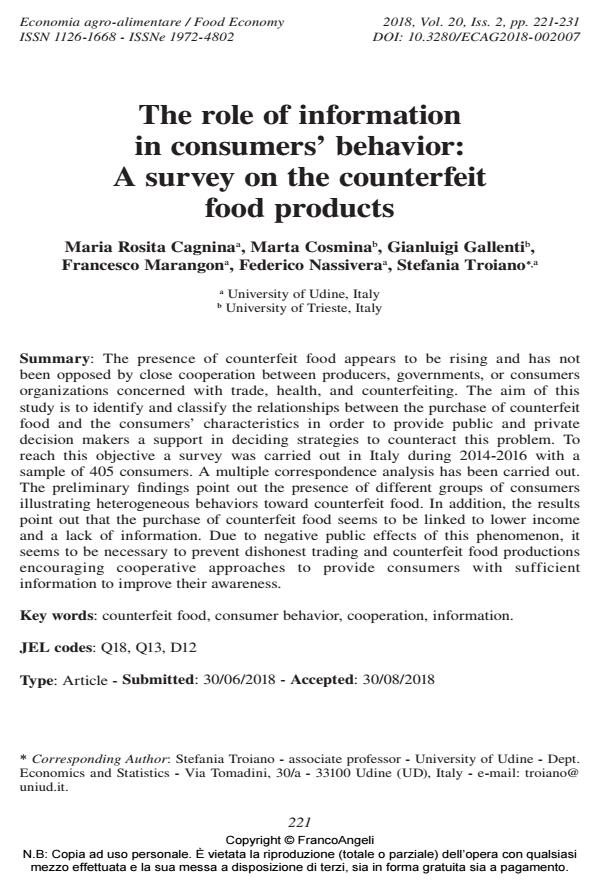The role of information in consumers’ behavior: A survey on the counterfeit food products
Journal title ECONOMIA AGRO-ALIMENTARE
Author/s Maria Rosita Cagnina, Marta Cosmina, Gianluigi Gallenti, Francesco Marangon, Federico Nassivera, Stefania Troiano
Publishing Year 2018 Issue 2018/2
Language English Pages 11 P. 221-231 File size 116 KB
DOI 10.3280/ECAG2018-002007
DOI is like a bar code for intellectual property: to have more infomation
click here
Below, you can see the article first page
If you want to buy this article in PDF format, you can do it, following the instructions to buy download credits

FrancoAngeli is member of Publishers International Linking Association, Inc (PILA), a not-for-profit association which run the CrossRef service enabling links to and from online scholarly content.
The presence of counterfeit food appears to be rising and has not been opposed by close cooperation between producers, governments, or consumers organizations concerned with trade, health, and counterfeiting. The aim of this study is to identify and classify the relationships between the purchase of counterfeit food and the consumers’ characteristics in order to provide public and private decision makers a support in deciding strategies to counteract this problem. To reach this objective a survey was carried out in Italy during 2014-2016 with a sample of 405 consumers. A multiple correspondence analysis has been carried out. The preliminary findings point out the presence of different groups of consumers illustrating heterogeneous behaviors toward counterfeit food. In addition, the results point out that the purchase of counterfeit food seems to be linked to lower income and a lack of information. Due to negative public effects of this phenomenon, it seems to be necessary to prevent dishonest trading and counterfeit food productions encouraging cooperative approaches to provide consumers with sufficient information to improve their awareness.
Keywords: Counterfeit food, consumer behavior, cooperation, information.
Jel codes: Q18, Q13, D12
- New Metropolitan Perspectives Alessandro Scuderi, Roberta Selvaggi, Luisa Sturiale, Giovanni La Via, Giuseppe Timpanaro, pp.1384 (ISBN:978-3-031-06824-9)
- Information and Communication Technologies for Agriculture—Theme IV: Actions Alessandro Scuderi, Giuseppe Timpanaro, Luisa Sturiale, Giovanni La Via, Biagio Pecorino, pp.155 (ISBN:978-3-030-84155-3)
- The implementation of EU Optional Quality Term "Mountain Products" in Italy: Challenges and opportunities for the food sector in rural mountain areas Sara Bispini, Riccardo Ievoli, Mauro Conti, Angelo Belliggiano, in Economia agro-alimentare 2/2025 pp.163
DOI: 10.3280/ecag2025oa18773 - Exploring the Halal Industry and Its Business Ecosystem Prospects Antonio Cuciniello, pp.53 (ISBN:9798369386187)
- Eliciting Consumers’ Health Consciousness and Price-Related Determinants for Polyphenol‐Enriched Olive Oil Raffaele Zanchini, Giuseppe Di Vita, Daniela Spina, Anna Irene De Luca, Mario D’Amico, in NJAS: Impact in Agricultural and Life Sciences /2022 pp.47
DOI: 10.1080/27685241.2022.2108733 - Scalable Film Based on Thermochromic and Radiative Cooling Effects for Anti-Counterfeiting and Low Temperature Preservation Bo Xiang, Luyao Xu, Yufei Li, Liyuan Jiao, Rong Zhang, in ACS Applied Polymer Materials /2024 pp.12568
DOI: 10.1021/acsapm.4c02117
Maria Rosita Cagnina, Marta Cosmina, Gianluigi Gallenti, Francesco Marangon, Federico Nassivera, Stefania Troiano, The role of information in consumers’ behavior: A survey on the counterfeit food products in "ECONOMIA AGRO-ALIMENTARE" 2/2018, pp 221-231, DOI: 10.3280/ECAG2018-002007